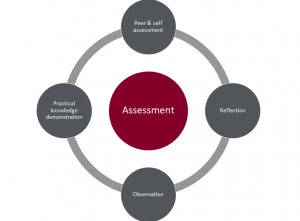Reflection
Each chapter in this book is accompanied by a section for reflection. This is an opportunity to take the learning in this book further and personalize it. Instructors may wish to take select reflection questions and turn them into class assessments if desired.
 Nuu-Chah-Nulth author Kelly Johnsen states in their dissertation “Initial investigation into traditional Indigenous assessment practices reveal the possibilities of peer – and self- assessment, reflection, observation and practical knowledge demonstration. Combinations of these constructivist assessment methods may reflect student learning as rigorously as do summative assessment methods[…] Reflective skills may be improved via group work, self-reflection and discourse with the instructor. The instructor may assign assessment weight to observation of student progress, which is often already integrated into a mark percentage assigned to ‘participation’. These forms of assessment reflect a more authentic integration of Indigenization than do written research papers and anxiety-inducing written exams” (Johnsen, 2019, p. 59). The shift to constructivist assessment methods supports “relationship strengthened … learning” (Johnsen, 2019, p. 60). Indigenous assessment juxtaposes with Eurocentric “consumptive pedagogy as looking at knowledge as something to be consumed; subsequently this consumption can be measured quantitatively through standardized testing.” (Johnsen, 2019, p. 61). Johnson offers a range of ways you might consider integrating the reflection component of this book into your course. I would encourage you to consider which methods might best be integrated into your curriculum.
Nuu-Chah-Nulth author Kelly Johnsen states in their dissertation “Initial investigation into traditional Indigenous assessment practices reveal the possibilities of peer – and self- assessment, reflection, observation and practical knowledge demonstration. Combinations of these constructivist assessment methods may reflect student learning as rigorously as do summative assessment methods[…] Reflective skills may be improved via group work, self-reflection and discourse with the instructor. The instructor may assign assessment weight to observation of student progress, which is often already integrated into a mark percentage assigned to ‘participation’. These forms of assessment reflect a more authentic integration of Indigenization than do written research papers and anxiety-inducing written exams” (Johnsen, 2019, p. 59). The shift to constructivist assessment methods supports “relationship strengthened … learning” (Johnsen, 2019, p. 60). Indigenous assessment juxtaposes with Eurocentric “consumptive pedagogy as looking at knowledge as something to be consumed; subsequently this consumption can be measured quantitatively through standardized testing.” (Johnsen, 2019, p. 61). Johnson offers a range of ways you might consider integrating the reflection component of this book into your course. I would encourage you to consider which methods might best be integrated into your curriculum.
Exercises
Reflection on Territorial Acknowledgement
- Whose land are you on?
- What is the history of that land? Are there treaties or is the land unceded?
- What language/s belong to the Indigenous Peoples of the land?
- How are Indigenous Peoples history and language/s represented and acknowledged within your school, community, and government?

